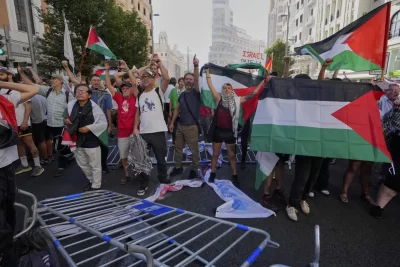
JERUSALEM — Israeli Prime Minister Benjamin Netanyahu vowed revenge Friday for what he described as a “cruel and malicious violation” of the ceasefire agreement after authorities determined that a body released by Hamas was not an Israeli mother of two small boys, as the militant group had promised.
The incident raised new doubts about the future of the fragile ceasefire deal, which has paused over 15 months of war but is nearing the end of its first phase. In the short term, though, there were indications that the deal’s next step — the release of six living Israeli hostages on Saturday in exchange for hundreds of Palestinian prisoners — would proceed as planned.
Hamas suggested in a statement Friday that a mix-up of remains might have occurred after Israel bombed the area where both the Israeli hostages and Palestinians were present. The group said it would “conduct a thorough review.”
Later on Friday, the Red Cross said in a short statement it had received human remains inside Gaza and transferred them to Israeli authorities. The remains were expected to be taken to Israel’s national forensics lab for testing. It was not immediately known how long it would take to confirm identification.
Speaking during a phone interview with Al Araby, a Qatar-based television network, Hamas leader Mahmoud Mardawi confirmed the militants handed over the body of Shiri Bibas to the Red Cross.
Dr. Salem Attalah, deputy secretary general for the Palestinian Mujahedeen Brigades, said it handed over Bibas’ remains to the Red Cross. The militant group, which collaborates with Palestinian Islamic Jihad inside Gaza, is thought to have been holding the mother and her two boys, Kfir and Ariel Bibas.
In other developments, U.S. President Donald Trump said Friday that he will not try to muscle through his plan for the United States to take over and rebuild the Gaza Strip into a tourist destination, displacing Palestinians. The plan was welcomed by Netanyahu but universally rejected by Palestinians and Arab countries. Hamas’ military wing, the Al-Qassam Brigades, said it would go ahead with the release of the six Israeli hostages Saturday.
Hamas turned over four bodies Thursday as part of the ceasefire deal. They were supposed to have been those of Shiri Bibas, her sons, Kfir and Ariel, and Oded Lifshitz, who was 83 when he was abducted during the Oct. 7, 2023, attack by Hamas that ignited the war.
Israeli authorities said they had positively identified the remains of the two boys and of Lifshitz. However, the fourth body was determined to be that of an unidentified woman from Gaza.
“We will work with determination to bring Shiri home together with all our hostages — both living and dead — and ensure that Hamas pays the full price for this cruel and malicious violation of the agreement,” Netanyahu said. “The sacred memory of Oded Lifshitz and Ariel and Kfir Bibas will be forever enshrined in the heart of the nation. May God avenge their blood. And so we will avenge.”
Hamas said it had “no interest in retaining any bodies,” adding that it had “demonstrated full compliance with the agreement” in recent days and remained “committed to all its terms.”
“We reject Netanyahu’s threats, which serve only to manipulate Israeli public opinion,” Hamas said, calling on mediators to ensure the continued implementation of the ceasefire. The group also called for the return of the unidentified remains.
Netanyahu’s vow for revenge was rejected by the aunt of the Bibas children, who said Israeli officials had failed to protect them on the day of the attack and then abandoned them in captivity.
“Prime Minister Benjamin Netanyahu, we did not receive an apology from you in this painful moment,” Ofri Bibas Levy said in a video statement released Friday by a group representing the families of hostages. “We are not seeking revenge right now. We are asking for Shiri.”
The confusion over the body’s identity was a shocking twist in the saga of the Bibas family, which has been widely viewed as a symbol of the Israeli hostages’ plight.




